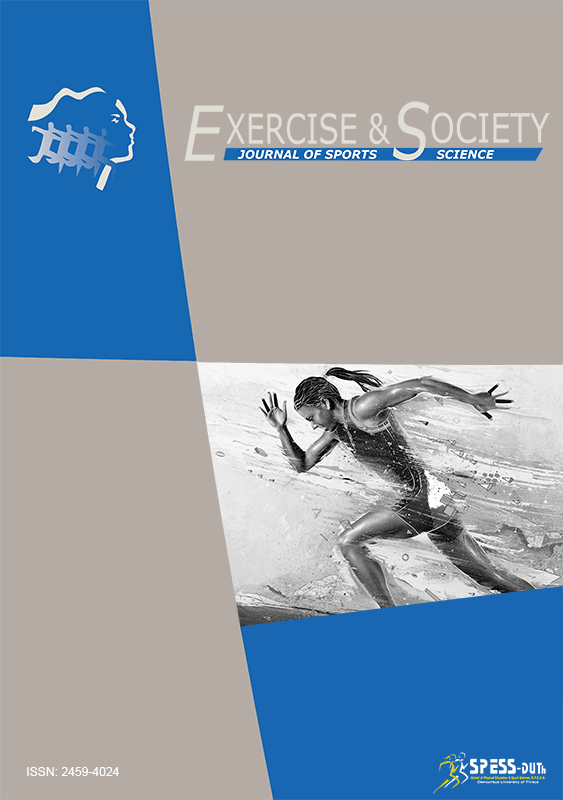Comparative study on the effect of serving and receiving a ball on the outcome of a match between winners and losers boys’ table tennis athletes through video-analysis
Abstract
The purpose of the current study was to record and compare the effect of ball serving and receiving on the outcome of a match between winners and losers table tennis athletes in the junior division. The sample of the research was consisted of 54 matches (2.921 phases) from group stage, round of 16, quarter finals, semifinals and finals conducted during the official development leagues and the 2016-17 Greek national championship in which male athletes of the age group 14 ± 1.52 participated. There was recorded and compared the serving grip, the server’s scoring point, the success percentages of the receiver and the way of receiving the serve. These elements were recorded using video-analysis and for the statistical treatment of the data the non-parametric x2 test was applied. From the derived data significant differences between boys who have won or lost a match were observed: boys who have won preferred to use forehand grip, the ball server winners statistically outnumbered to a significant extent the losers in scoring points and in the successful ball receptions. Remarkable statistical differences were also found on the way of receiving the ball. The winners had the tendency to use more often forehand flick, backhand flick and forehand topspin actions. The aforementioned findings could help coaches to improve their training methods and the effectiveness of their instructions during a match’s progress.
Key words: table tennis; serve; receive; video-analysis.
References
Baca, A. (2003). Computer Science Based Feedback Systems on Sports Performance. International Journal of Computer Science in Sport, 2, 57-69.
Bahamonde, R.E. (2000). Changes in angular momentum during the tennis serve. Journal of Sports Sciences 18, 579-592.
Djokic, Z., Munivrana, G., & Levajac, D. (2015). Match analysis of final game of Men’s World Championships 2014- China vs Germany. 14th IITF Sports Science Congress and 5th World Racquet Sports Congress. Book of Abstracts, p.115.
Djokic, Z., Munivrana, G., & Levajac, D. (2017). Role of serve and return of a serve at European games 2015 table tennis tournament. 15th ITTF Sports Science Congress, Dusseldorf, Book of Abstracts, p.50.
Djokic, Ζ. (2000). Structure of competitors activities of top table tennis players. The 6th ITTF Sport Science Congress. Kuala Lumpur (Malaysia).
Djokic, Z. (2007). ITTF scored a goal (changes of rules in table tennis during 2000-2003). Proceedings of 10th International Table Tennis Sports Science Congress. Zagreb: University of Zagreb.
Drianovski, Y., & Otcheva, G. (2002). Survey of the game styles of some of the best Asian players at the 12th World University Table Tennis Championships (Sofia, 1998)’, in Yuza, S., Hiruta, Y., Iimoto, Y., Shibata, Y., Tsuji, J.R., Harrison, A., Sharara, J.F., Khan, K., Kimura & Araki, S. (eds), Table Tennis Sciences 4 and 5, 3–9. Lausanne: ITTF
Guo-bing, L., & Shuai, L. (2015). Analysis about Technologies and Tactics Of Ma Long and Mizutani Jun. 14th IITF Sports Science Congress and 5th World Racquet Sports Congress. Book of Abstracts p 137.
Katsikadelis, M., Pilianidis, T., & Mantzouranis, N. (2013). The interaction between serves and match winning in table tennis players in the London 2012 Olympic Games. The 13th ITTF Sports Science Congress. Paris, Book of abstracts p.77.
Ma, L., Son, C., Sun, B., Cai, X., Huang, W.Y., & Kang, X.J (2015). Analysis on Technique and Tactics of Ma Long and Zhang Jike. 14th IITF Sports Science Congress and 5th World Racquet Sports Congress, Book of Abstracts p 57.
McAffe, R. (2006). Table tennis step to success. Human Kinetics.
Πετρίδου, A., Teρζόγλου, M., & Μασταρίδης, A. (2011). Analyzing table tennis games in high level athletes. Πρακτικά 19ου Διεθνούς Συνεδρίου Φυσικής Αγωγής. ΤΕΦΑΑ, Δημοκρίτειο Πανεπιστήμιο Θράκης, Κομοτηνή.
Seemiller, D., & Holowchak, M. (1997). Winning table tennis, publish: Human Kinetics, United States of America.
Sindik, J., Fuchs, M., Lames, M., Matjasic, T., & Kondric, M. (2017). Differences in match statistics during table tennis team event in Rio and London Olympic Games. 15th ITTF Sports Science Congress, Dusseldorf , Book of Abstracts, p.27.
Sklorz, M., & Michaelis, R. (1981). Αυτό είναι το πινγκ-πονγκ από τη θεωρία στη πράξη Εκδόσεις Αλκυών, Αθήνα.
Wu, Xiao, Zu, & Escobar, V.J. (2007). Notational analysis for competition in table tennis “part-2” 10th ITTF sports congress – Croatia.
Yu, F., Chen, K., & Wang, P. (2015). A Study on the Technical Analysis of Women’s table tennis players in 2012 London Olympic. 14th IITF Sports Science Congress and 5th World Racquet Sports Congress, Book of Abstracts p 124.
Yu, L., Ling, P., & Zhang, H. (2010). Study on the decision support system of techniques and tactics in net sports and the application in the Beijing Olympic Games. Proceedings of WRI Global Congress on Intelligent Systems, p. 170-174.
Yu, Y., Chu, T., Lee, S., & Puglissi, M. (2015) Relationship between USA table tennis rating and technical feature intermediate players. 14th IITF Sports Science Congress and 5th World Racquet Sports Congress, Book of Abstracts p 107.
Downloads
Published
How to Cite
Issue
Section
License
Authors who publish with this journal agree to the following terms:
a. Authors retain copyright and grant the journal right of first publication with the work simultaneously licensed under a Creative Commons Attribution License that allows others to share the work with an acknowledgement of the work's authorship and initial publication in this journal.
b. Authors are able to enter into separate, additional contractual arrangements for the non-exclusive distribution of the journal's published version of the work (e.g., post it to an institutional repository or publish it in a book), with an acknowledgement of its initial publication in this journal.
c. Authors are permitted and encouraged to post their work online (e.g., in institutional repositories or on their website) prior to and during the submission process, as it can lead to productive exchanges, as well as earlier and greater citation of published work (See The Effect of Open Access).


